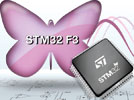

STMicroelectronics is now delivering the first samples of its new STM32 F3 series of microcontrollers, enabling early evaluation of this new line in ST’s product family featuring the ARM Cortex-M core embedded.
The MCUs are system-on-chip devices based on the Cortex-M4 core with FPU, and are optimised for efficient handling and processing of mixed signals in circuits such as three-phase motor controls, biometrics and industrial sensor outputs or audio filters. They are intended to simplify design, cut power consumption and reduce PCB size in consumer, medical, portable fitness, system monitoring and metering applications.
The new F3 series extends the scope of ST’s STM32 family by allowing designers to tackle mixed-signal control applications. Featuring versatile analog circuitry, the series provides low to medium memory sizes. The Cortex-M4 with FPU core augments the proven Cortex-M3 CPU with additional digital signal processing (DSP) capability, optimised single-cycle and saturating arithmetic instructions, and floating-point unit (FPU), to boost performance over ST’s STM32 F1 Cortex-M3 devices.
Its features position the new series between the STM32 F1 and the STM32 F4, which features the Cortex-M4 with FPU core and large memory capacity combined with high-speed 168 MHz maximum CPU frequency for complex applications.
With the new F3 microcontrollers, ST’s STM32 family now offers more than 350 variants addressing applications from entry-level, price-sensitive designs through to those demanding high performance and rich on-chip features. The F3 family comprises four product lines, differentiated according to on-chip memory density and integrated peripherals.
STM32 F30x devices have seven fast comparators with 50 ns response time, four programmable gain amplifiers supporting four different gain settings with 1% accuracy, two 12-bit DACs, and four 12-bit, 5 MSps ADCs. ADC performance can extend up to 18 MSps in interleaved mode.
The devices also have two advanced motor-control timers running at up to 144 MHz. These allow one microcontroller to manage two motors plus power factor correction (PFC) via its on-chip analog peripherals, in equipment such as home appliances. Among other capabilities of the advanced timers, timing resolution better than 7 ns allows applications such as digital power supplies in telecom infrastructure or data servers, micro-inverters in solar installation and LED lighting.
To help developers optimise code execution time, the F30x devices have 8 KB of SRAM mapped to the instruction bus as Core Coupled Memory (CCM-SRAM). Critical routines loaded in the 8 KB CCM at startup can be completed at full speed with zero wait states, achieving 94 Dhrystone MIPS at 72 MHz. This compares with 62 DMIPS when executing from Flash or SRAM; equivalent to a 52% performance increase for critical routines.
The F30x series also has up to 40 KB of SRAM mapped on the data bus. The 8 KB CCM-SRAM can also be used for data storage with no performance trade-off. Devices are pin-compatible with the STM32 F1 series, and also share the same API, which simplifies migration to higher-performing devices.
The F37x devices deliver a different blend of peripheral functions. They are the first microcontrollers from ST to integrate a 16-bit Sigma-Delta ADC on-chip, allowing the STM32 family to solve a wider range of precision-sensing applications and providing a single-chip solution capable of replacing a discrete general-purpose processor and separate ADC.
Up to three 16-bit Sigma-Delta ADCs are integrated on-chip, with separate analog supply from 2,2 V to 3,6 V, up to 21 single or 11 differential channels, and seven programmable gains per channel.
Other STM32 F37x analog peripherals include two fast comparators, three 12-bit DACs and one 12-bit, 1 MSps ADC. There is also an enhanced CEC (Consumer Electronics Control) unit, making these devices relevant for consumer multimedia products.

© Technews Publishing (Pty) Ltd | All Rights Reserved